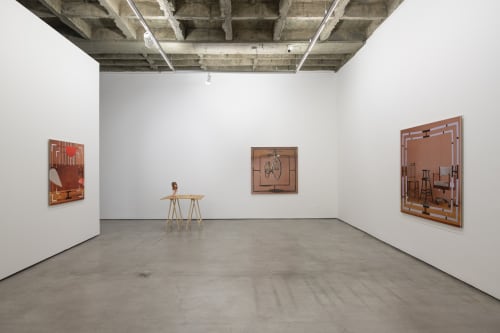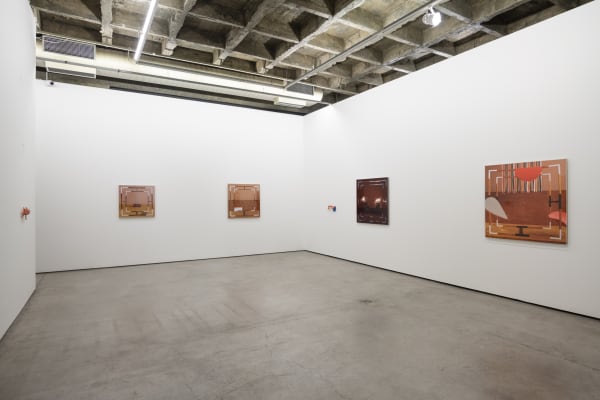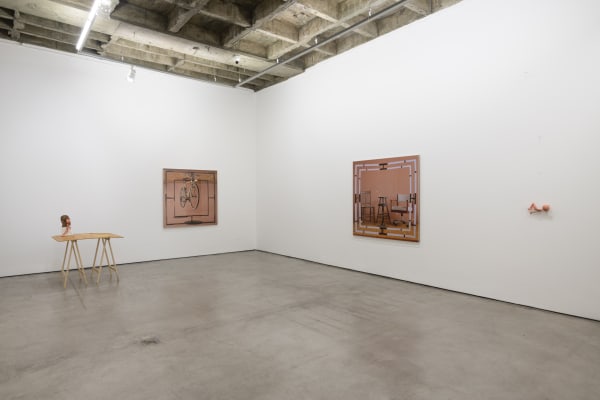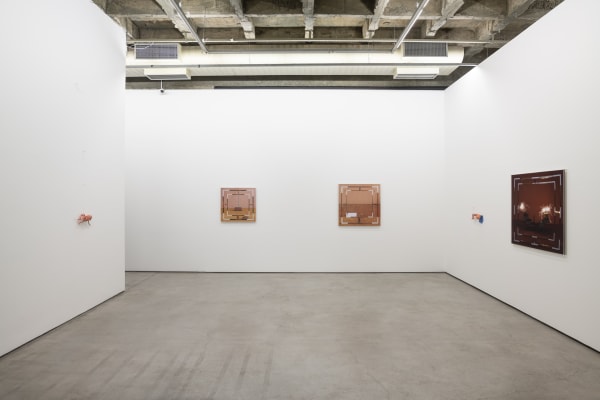Taking Sides: Brian Griffiths + Frank Kent
“I make sculpture because it sits in the world with us, like us. It is inanimate and yet defines us. Self and stuff seem always mixed up. I am drawn to how we think with things and how things think. In the studio I negotiate between what I want, and what the things need. This is often a situational comedy. I consider sculpture a social act, a social investigation, a type of unruly collective storytelling. I am concerned with how my sculpture differs from objects in general circulation as commodities, and what relations and values this difference sets up. I make art that is full of contradictions, fallibility and feelings – something that is unremarkably tired, as an alternative to the shiny and box- fresh. I am making a place for us, for the human.” [Brian Griffiths, 2019]
Taking Sides, the fourth solo show of the artist with Galeria Luisa Strina, present two different series of works: No No to Knock-Knocks, versions of a sculptural character by Brian Griffiths, and AIR SIGNS, a series of photographs by Brian Griffiths and Frank Kent.
No No to Knock-Knocks is a tragi-comic figure: a naked, puppet-like Caucasian male who seems not to know that his strings – if they ever held him up – have now been decisively cut. Bald, blind, and with his pink paintwork and wooden body showing signs of wear and tear, this little performer clunks through his part.
In his book Puppet: An Essay on Uncanny Life (2011), Kenneth Gross writes that ‘the puppet serves as an ambassador or pilgrim to human beings from the world of things’. It is an object ‘that has got an education, that has learned to act’. Griffiths’ not-quite-puppets are ambiguous performers, eliciting both laughter and sympathy. Material objects rather than living bodies, they are fated to take to the stage despite the implausible ‘woodenness’ of their acting, to communicate only through their own dull matter.
In Taking Sides this character turns up to hang-out, to nap, or possibly play dead; punctuating the space like an uneventful comic strip. This impulse to slow down, to linger, can be traced to absurdist traditions, in particular Samuel Beckett’s work were action tends to stall. This little character has also a touch of the vaudeville entertainer about him – he plays the slapstick comic with great panache and manages to evoke charm and pathos through failure. The figure’s postures and rudimentary fixings speak of their ongoing improvisatory potential; these artworks admit the prospect of their own reshaping. His time seems expansive, his situation changeable; yet this ‘everyman’ archetype lost and blind to his predicament and the problems of such ‘man-made’ self-serving universal ideas.
Brian Griffiths and Frank Kent share a studio, they split the studio directly down the middle, they take sides. They have made photographic works together collectively called AIR SIGNS. These are an ongoing series of sculptural works that are presented as photographs. It is a collaboration that presents objects from their studio, and occasionally, from the artists’ lives.
AIR SIGNS values improvised approach to formal arrangements and the celebration of life and art. Objects are displayed, positioned and pressed into action within a wooden cube. This constant framework flattens three- dimensions and directs focus, it creates a space to isolate and scrutinize everyday things. The velvet stage becomes a dramatic and ostentatious surface which holds the objects whilst uncontrollably tracking light and activity. These images shift satisfyingly somewhere between a document and dream, reason and intuition; they quietly, but insistently, suggest image into oddly shaped thoughts, or speech bubbles.
These frames also establish structure and order – as objects, action, and the photographic process itself, attempts to disrupt. As with all frames or borders – it privileges and ignores (taking sides again) – it presents a world not the world, it admits that reality is not something outside, but something we compose every moment, with a constant interpretation of fact and fiction, objective and subjective.
These works enter into art historic dialogue with other photographed sculptural works of Brassaï Involuntary Sculptures, Brancusi’s radiant studio photos , Peter Fischli & David Weiss photographs of balancing of everyday objects (Equilibrium Series), Gabriel Orozco’s imaging of everyday objects (like Cats and Watermelons, 1992) , Marcel Broodthaers (like Daguerre’s Soup, 1974). Griffiths’ practice has always negotiated the histories and languages of sculpture and its doubleganger, the object – he utilizes the position that sculpture can no longer signify something specific, but rather to indicate a polymorphous objecthood.
Brancusi articulated the studio around groupes mobiles (mobile groups), through categories of sculpture, bases, and pedestals. Griffiths and Kent have set up a more relaxed and open grouping strategies where approaches can be reconfigured daily. This results in pictures shifting attitude, from the literal and obvious to the magically obscure; in the photograph Power, History and Comfort (2019) all the chairs from the artists’ studio are collected together. Through this simple arrangement the work starts to speak of different spaces, activities (work and leisure) and periods of design; in Germany to Spain, England back to Germany (2019) an array of green objects are lined up, the title absurdly maps out the objects origins; in European Magic (2019) a bike flies through the dusk lit studio.







